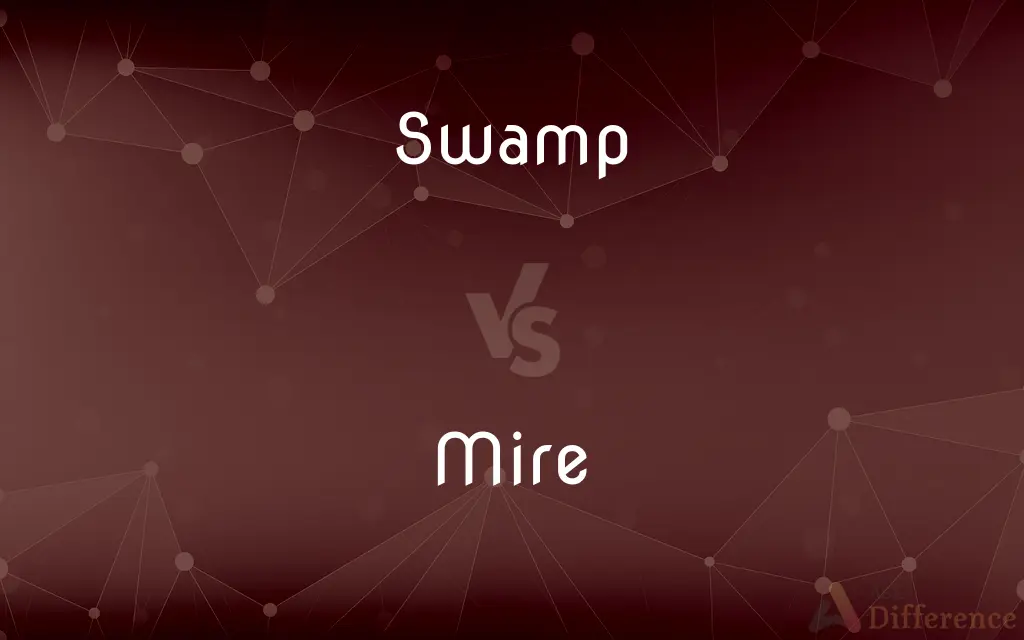Swamp vs. Mire — What's the Difference?
Edited by Tayyaba Rehman — By Maham Liaqat — Updated on March 14, 2024
A swamp is a wetland with standing water and vegetation, often home to diverse wildlife. A mire is a type of wetland characterized by peat deposits, which can be acidic and less biodiverse than swamps.

Difference Between Swamp and Mire
Table of Contents
ADVERTISEMENT
Key Differences
Swamps and mires are both types of wetlands, ecosystems where water covers the soil for much of the year. Mires, on the other hand, are wetlands that accumulate peat, a deposit of lost plant material—often mosses, in particular sphagnum.
While swamps are dynamic, with water flow contributing to their ecological diversity, mires are more stable environments where the slow accumulation of peat leads to the creation of unique ecosystems. Both are critical for biodiversity, but swamps tend to be more directly involved in supporting a wide variety of animals and plants due to their nutrient-rich waters and diverse vegetation.
The presence of trees is a defining feature of many swamps, allowing them to support various bird, mammal, and insect species. Mires, with their peat-rich soil, support a different set of plant and animal life, often specialized species that have adapted to the low-nutrient conditions. Both swamps and mires provide essential ecosystem services, including water filtration, flood mitigation, and acting as vital carbon stores, but they do so in markedly different ways due to their distinct characteristics.
Swamps are typically found in warm, humid climates and are known for their rich biodiversity, including a variety of trees, plants, and wildlife. Mires can be divided into two main types: bogs and fens. Bogs are acidic, low in nutrients, and rely on precipitation for their water source, which limits their plant and animal diversity.
Comparison Chart
Water Source
Freshwater or saltwater, with flow
Primarily precipitation, stagnant
ADVERTISEMENT
Vegetation
Diverse, including trees and shrubs
Peat-forming plants, like sphagnum moss
Biodiversity
High, supports various wildlife
Lower, specialized species adapted to acidity
Soil Type
Varied, often rich in nutrients
Peat, acidic and low in nutrients
Function
Flood control, habitat, water purification
Carbon storage, unique ecosystems
Types
Freshwater swamps, saltwater swamps
Bogs (acidic), fens (less acidic)
Compare with Definitions
Swamp
Wetland with standing water.
The Florida Everglades is a vast freshwater swamp.
Mire
Wetland accumulating peat.
The northern hemisphere contains vast mire landscapes.
Swamp
Filters water.
Swamps can purify water by trapping pollutants.
Mire
Divided into bogs and fens.
Fens are mires that receive nutrient-rich water from the ground.
Swamp
Rich in wildlife.
Swamps are crucial habitats for birds, fish, and amphibians.
Mire
Characterized by sphagnum moss.
Sphagnum moss dominates the vegetation in many bogs.
Swamp
Supports diverse vegetation.
Cypress trees are common in many swamps.
Mire
Acts as a carbon sink.
Mires store carbon, reducing greenhouse gas emissions.
Swamp
Provides flood mitigation.
Coastal swamps help buffer storm surges.
Mire
Supports specialized species.
Carnivorous plants are common in nutrient-poor mires.
Swamp
A swamp is a forested wetland. Swamps are considered to be transition zones because both land and water play a role in creating this environment.
Mire
A mire, peatland, or quagmire is a wetland area dominated by living peat-forming plants. Mires arise because of incomplete decomposition of organic matter, usually litter from vegetation, due to water-logging and subsequent anoxia.
Swamp
An area of low-lying land that is frequently flooded, especially one dominated by woody plants.
Mire
A stretch of swampy or boggy ground
Acres of land had been reduced to a mire
Swamp
A lowland region saturated with water.
Mire
A complicated or unpleasant situation from which it is difficult to extricate oneself
The service is sinking in the mire of its own regulations
Swamp
A situation or place fraught with difficulties and imponderables
A financial swamp.
Mire
Cause to become stuck in mud
Sometimes a heavy truck gets mired down
Swamp
To drench in or cover with or as if with water.
Mire
An area of wet, soggy, muddy ground; a bog.
Swamp
To inundate or burden; overwhelm
She was swamped with work.
Mire
Deep slimy soil or mud.
Swamp
(Nautical) To fill (a ship or boat) with water to the point of sinking it.
Mire
A disadvantageous or difficult condition or situation
The mire of poverty.
Swamp
To become full of water or sink.
Mire
To cause to sink or become stuck in mire.
Swamp
A piece of wet, spongy land; low ground saturated with water; soft, wet ground which may have a growth of certain kinds of trees, but is unfit for agricultural or pastoral purposes.
Mire
To hinder, entrap, or entangle.
Swamp
A type of wetland that stretches for vast distances, and is home to many creatures which have adapted specifically to that environment.
Mire
To soil with mud or mire.
Swamp
(figurative) A place or situation that is foul or where progress is difficult.
Mire
To sink or become stuck in mire.
Swamp
To drench or fill with water.
The boat was swamped in the storm.
Mire
Deep mud; moist, spongy earth.
Swamp
(figurative) To overwhelm; to make too busy, or overrun the capacity of.
I have been swamped with paperwork ever since they started using the new system.
Mire
An undesirable situation, a predicament.
Swamp
(figurative) To plunge into difficulties and perils; to overwhelm; to ruin; to wreck.
Mire
An ant.
Swamp
Wet, spongy land; soft, low ground saturated with water, but not usually covered with it; marshy ground away from the seashore.
Gray swamps and pools, waste places of the hern.
A swamp differs from a bog and a marsh in producing trees and shrubs, while the latter produce only herbage, plants, and mosses.
Mire
(transitive) To cause or permit to become stuck in mud; to plunge or fix in mud.
To mire a horse or wagon
Swamp
To plunge or sink into a swamp.
Mire
(intransitive) To sink into mud.
Swamp
To cause (a boat) to become filled with water; to capsize or sink by whelming with water.
Mire
To weigh down.
Swamp
Fig.: To plunge into difficulties and perils; to overwhelm; to ruin; to wreck.
The Whig majority of the house of Lords was swamped by the creation of twelve Tory peers.
Having swamped himself in following the ignis fatuus of a theory.
Mire
(intransitive) To soil with mud or foul matter.
Swamp
To sink or stick in a swamp; figuratively, to become involved in insuperable difficulties.
Mire
An ant.
Swamp
To become filled with water, as a boat; to founder; to capsize or sink; figuratively, to be ruined; to be wrecked.
Mire
Deep mud; wet, spongy earth.
He his rider from the lofty steedWould have cast down and trod in dirty mire.
Swamp
Low land that is seasonally flooded; has more woody plants than a marsh and better drainage than a bog
Mire
To cause or permit to stick fast in mire; to plunge or fix in mud; as, to mire a horse or wagon.
Swamp
A situation fraught with difficulties and imponderables;
He was trapped in a medical swamp
Mire
To stick or entangle; to involve in difficulties; - often used in the passive or predicate form; as, we got mired in bureaucratic red tape and it took years longer than planned.
Swamp
Drench or submerge or be drenched or submerged;
The tsunami swamped every boat in the harbor
Mire
To soil with mud or foul matter.
Smirched thus and mired with infamy.
Swamp
Fill quickly beyond capacity; as with a liquid;
The basement was inundated after the storm
The images flooded his mind
Mire
To stick in mire.
Mire
A soft wet area of low-lying land that sinks underfoot
Mire
Entrap;
Our people should not be mired in the past
Mire
Cause to get stuck as if in a mire;
The mud mired our cart
Mire
Be unable to move further;
The car bogged down in the sand
Mire
Soil with mud, muck, or mire;
The child mucked up his shirt while playing ball in the garden
Common Curiosities
Can both swamps and mires be found in all climates?
Swamps are more common in warm, humid climates, while mires are found in cooler, temperate, and subarctic regions where peat accumulation is more likely.
What defines a mire?
A mire is a wetland that accumulates peat, often featuring sphagnum moss and specialized plant and animal species, and acts as a significant carbon sink.
Why are mires important for the environment?
Mires are critical for carbon storage, helping to mitigate climate change by trapping carbon in peat deposits and supporting unique ecosystems.
What is a swamp?
A swamp is a wetland ecosystem characterized by standing water, trees, and diverse wildlife, playing important roles in water purification and flood control.
How do swamps and mires differ in biodiversity?
Swamps generally have higher biodiversity due to nutrient-rich water and diverse habitats, while mires, especially bogs, support more specialized species due to acidic conditions.
Can the conservation of swamps and mires help combat climate change?
Yes, protecting these wetlands is vital for carbon sequestration, biodiversity conservation, and maintaining water quality, contributing to climate change mitigation.
What role do swamps play in flood control?
Swamps can absorb excess rainfall and slow down water flow, reducing the risk of floods downstream.
How do human activities impact swamps and mires?
Drainage, peat extraction, pollution, and land development threaten both swamps and mires, affecting their ecological functions and biodiversity.
How are swamps and mires studied and preserved?
Scientists study these ecosystems to understand their functions and threats, while conservation efforts aim to protect them through legislation, sustainable management, and restoration projects.
Are mires only composed of bogs?
No, mires include both bogs, which are acidic and watered by precipitation, and fens, which are less acidic and may receive groundwater or surface water.
Share Your Discovery

Previous Comparison
Policeman vs. Fireman
Next Comparison
Amp vs. ImpAuthor Spotlight
Written by
Maham LiaqatEdited by
Tayyaba RehmanTayyaba Rehman is a distinguished writer, currently serving as a primary contributor to askdifference.com. As a researcher in semantics and etymology, Tayyaba's passion for the complexity of languages and their distinctions has found a perfect home on the platform. Tayyaba delves into the intricacies of language, distinguishing between commonly confused words and phrases, thereby providing clarity for readers worldwide.
















































